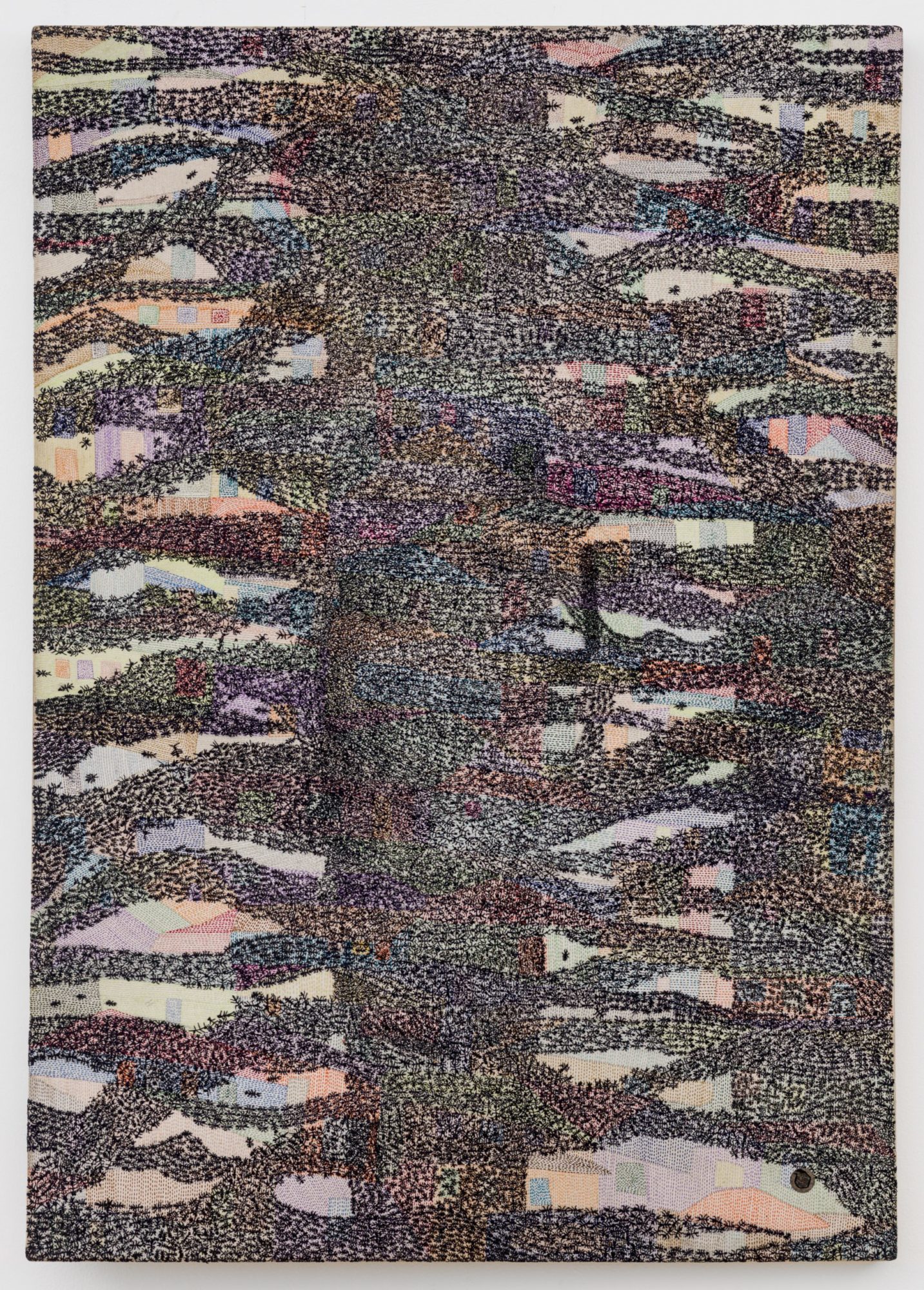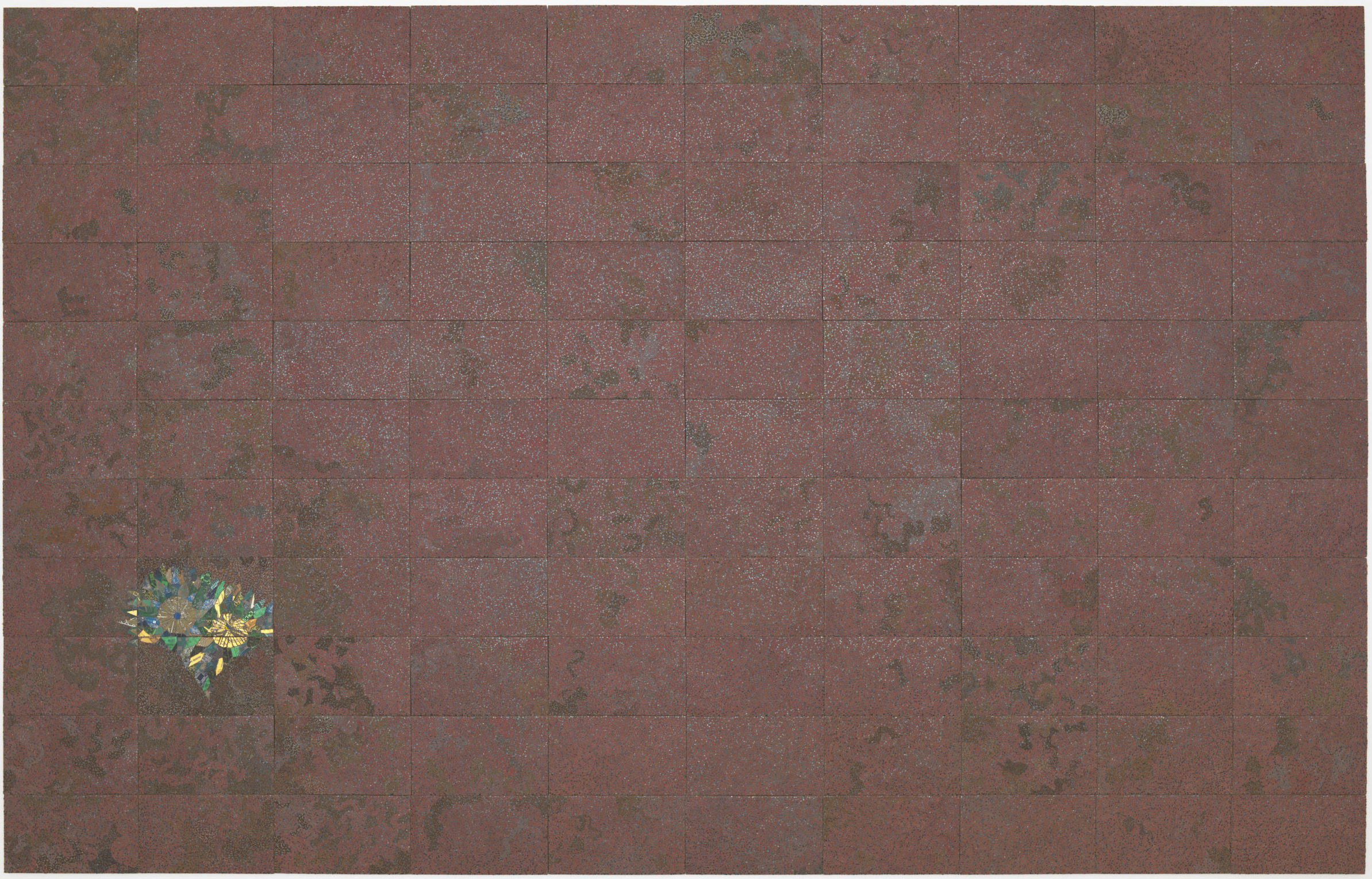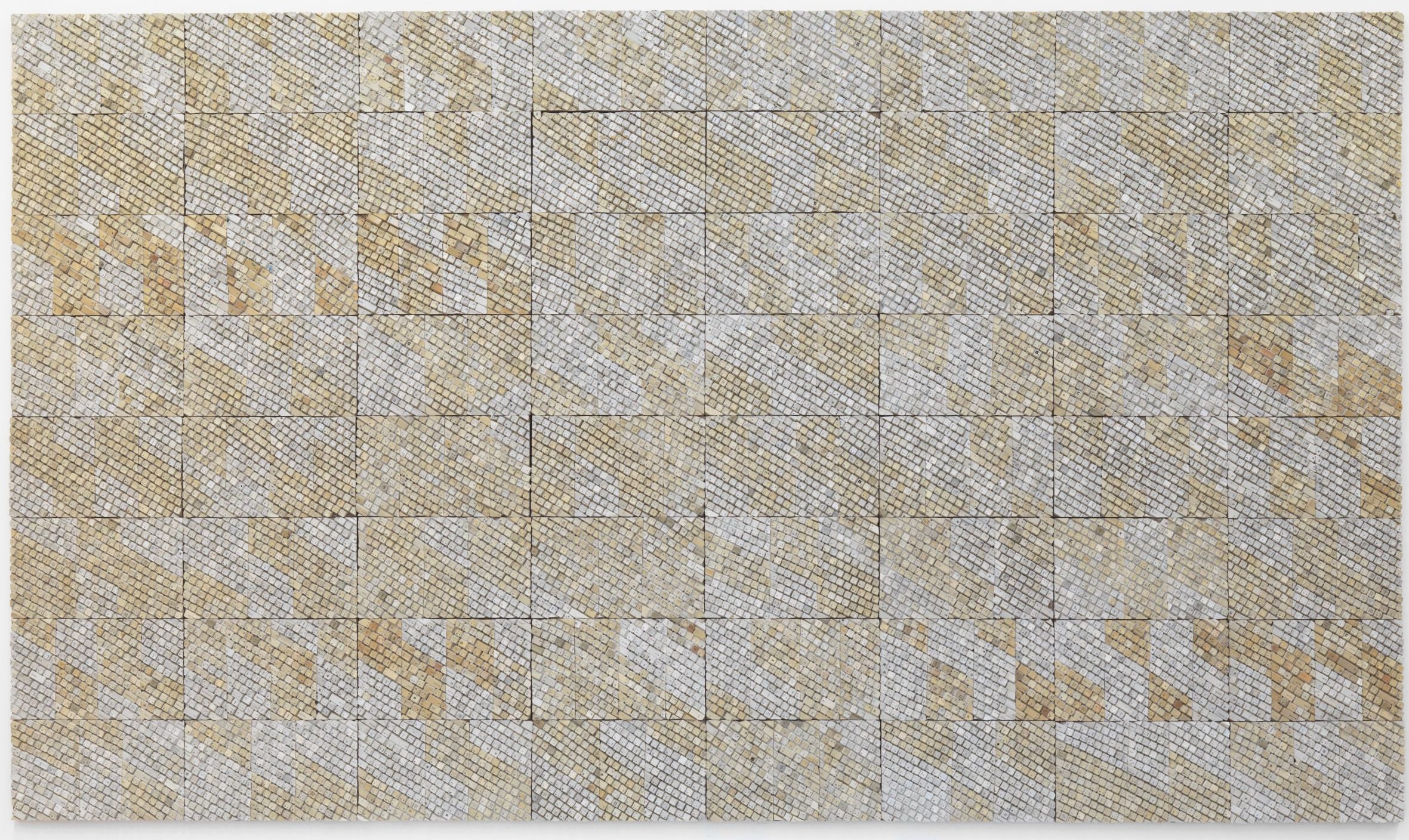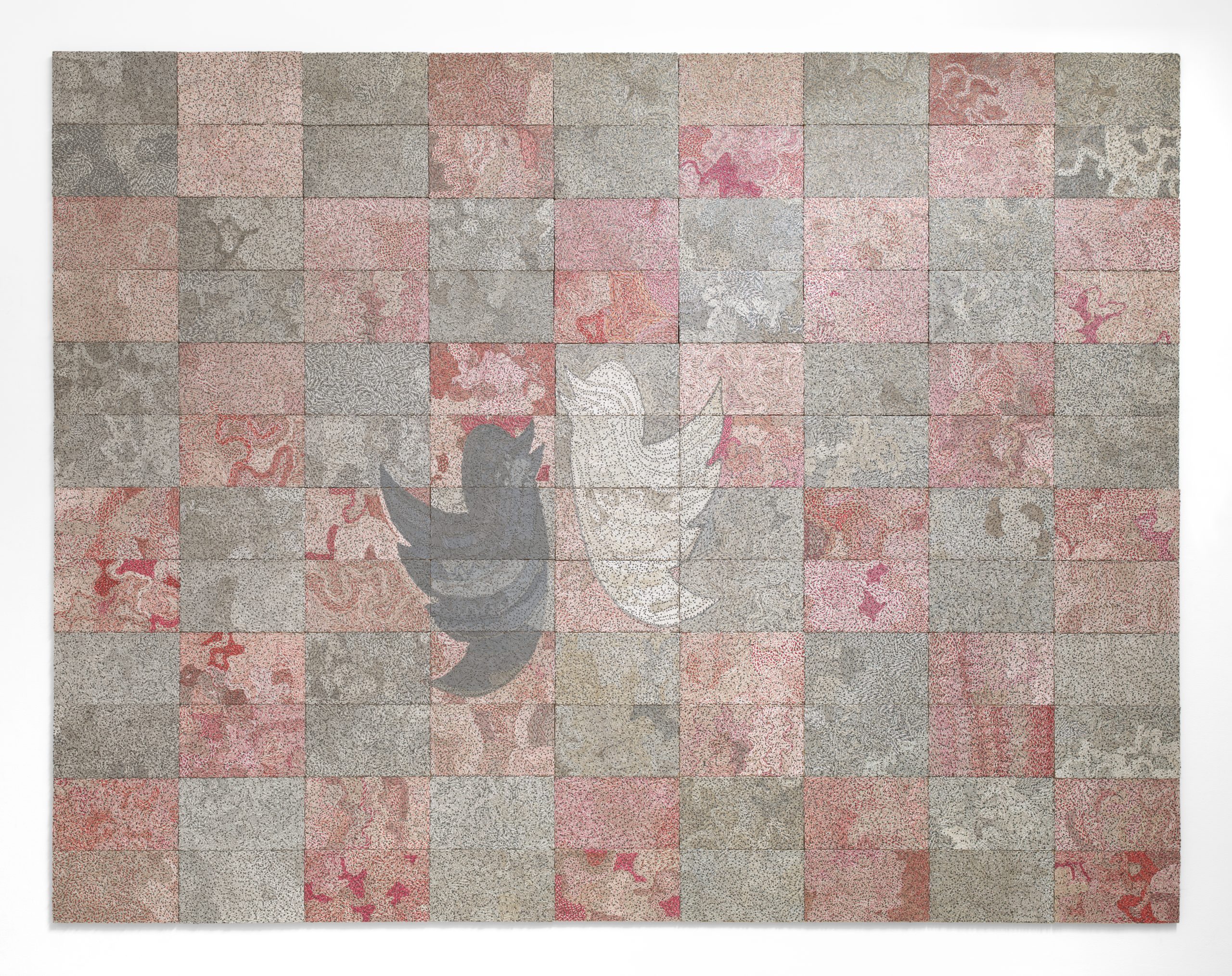Elias Sime: Tightrope
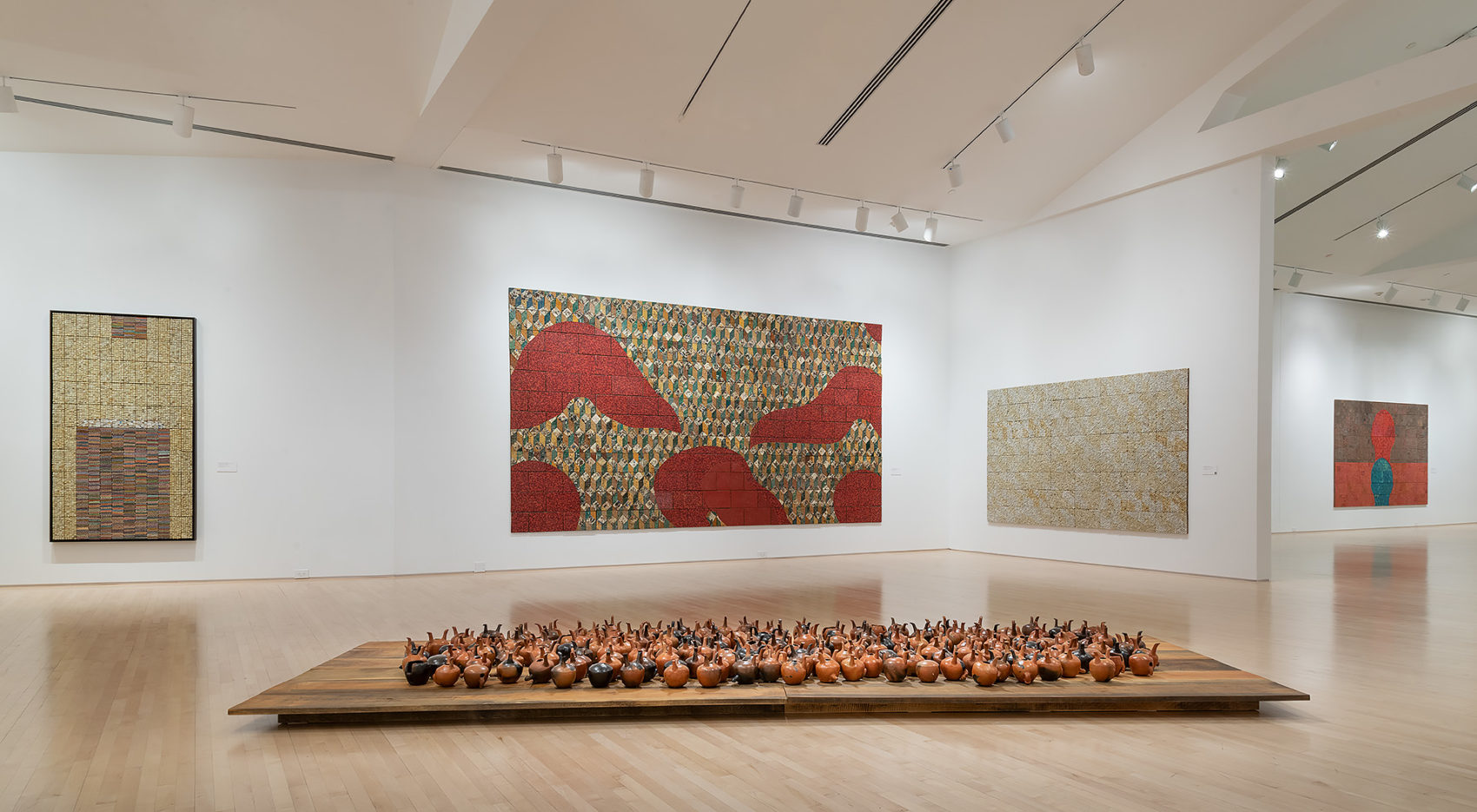
Installation view, Elias Sime: Tightrope, 2020, Charlotte Crosby Kemper Gallery, Kemper Museum of Contemporary Art [photo: E. G. Schempf]
Share:
Tightrope walking describes a precarious existence. A sole performer maintains balance along a tensioned wire, stretched between two points, often at a theatrical height for added suspense. The seemingly impossible act is possible because of a harmony of elements. The performer manages sway through footing and a balancing tool, and the tension provides resistance to work against. The result is a careful yet wondrous journey. At the Kemper Museum of Contemporary Art in Kansas City, MO, Tightrope describes a different yet similarly precarious circumstance.
The first major museum show of artist Elias Sime in the United States, this exhibition features more than two dozen tableaux and sculptural assemblages, many of which are from Sime’s Tightrope series. The exhibition begins with Sime’s early stitched canvas works that immediately preceded works from the Tightrope series and overlapped with them. Although differing in materials and methods, the artworks in the first room provide thematic introductions to the exhibition. Ants and Ceramicists 11 is a subtly colorful stitched canvas with black rivulets flowing horizontally across a central black column. Closer inspection reveals the rivulets and column to be a multitude of individually stitched ants. These stitched ants serve as a dynamic visual element within the artwork but also symbolize themes of community and collectivism central to Sime’s work. Depictions of ants do not reoccur beyond the first room, but their initial inclusion primes viewers to consider the role of the individual in the group. On the wall adjacent to Ants and Ceramicists 11 hangs the first artwork in the exhibition to incorporate salvaged electronic components. Tightrope: Hands and Feet consists of precisely cut, irregularly shaped motherboards, some of which have been shaped to represent hands and feet. Occasionally, in the minute space between motherboards, explosions of wire tumble forth from the picture plane. Rejecting terminology such as upcycling or e-waste, Sime carefully shapes motherboards in Tightrope: Hands and Feet to appear as both city maps and quilt patterns.
The second room showcases the breadth of materials and techniques employed by Sime. The artist sources all his materials from the markets of Addis Ababa, Ethiopia, but their actual origins are varied and indeterminate. The keyboards used in Tightrope: Silent 2 reflect their nebulous pasts. After extended use and time, the keyboards’ white keys begin to yellow, a visual record of their history. The final work comprises 64 panels of keyboards arranged so that they become a sea of softly changing yellows and whites. As hardware designed for digital communication, these keyboards now physically communicate a shared history and memory. Across the room, Tightrope: Internalized continues Sime’s use of electrical wiring as in Tightrope: Hands and Feet. Rather than allowing the wire to hang freely, as in that other work, Sime braids the wires into ropes that are nailed flat against the work’s surface. The braided wires, applied in serpentine patterns, create a turbulent sensation without sacrificing compositional harmony. Sime’s use of braided wire continues the theme of collectivism evoked by the ant iconography earlier in the exhibition. The wires alone make a chaotic bundle, but when braided, they create an elegant rope.
Elias Sime, Ants and Ceramicists 11, 2009–14, thread on canvas, signed with bottle cap, 73¼ x 53⅛ inches [© Elias Sime, courtesy of the artist and James Cohan, New York; photo: Adam Reich]
The third room of the exhibition presents the blissful resolution of material, method, and message, demonstrated most clearly in Tightrope: Noiseless 2. This monumental work uses rust-colored wire, a color not commonly found in computer wiring; thus, many years were required to accumulate the volume needed to complete the artwork. In the work’s finished state, swirling braided wires create a dappled ground from which a small floral grouping of motherboards bursts forth. The color of the wire resembles barren earth, initially creating a feeling of desolation, possibly caused by the harmful environmental tactics used to generate these materials. However, their treatment by the artist grants them an astrological feel, with the glints of the nail heads resembling stars. This transformative aspect is amplified by the green motherboards, which emerge confidently from this “earth.” Tightrope: Noiseless 2 combines the themes of interconnectivity and community throughout the exhibition and reminds viewers of these materials’ generative potential.
Elias Sime, Tightrope: Noiseless 2, 2019, reclaimed electronic components and insulated wire on panel, 100⅛ x 157⅞ inches [© Elias Sime, courtesy of the artist and James Cohan, New York; photo: Christopher Burke Studios]
Elias Sime, Tightrope: Silent 2, 2019, reclaimed electronic components on panel, 73¾ x 126½ inches [© Elias Sime, courtesy of the artist and James Cohan, New York; photo: Christopher Burke Studios]
After three rooms that present Sime’s lyrical transformation of repurposed materials, the final room of the exhibition may jar some visitors. Tightrope: (5) While Observing … offers an air of despondency. A sea of gray and blue braided wires covers the panel; a central group of keyless keyboards lies partially submerged beneath them. Immediately adjacent to the sinking keyboards is another large, braided wire work, Tightrope: Whirlwind. Incorporating a combination of red, white, and gray wires for its substrate, this artwork features the most recognizable iconography in the exhibition: the bird from the Twitter logo. Presented in its original white and its black inversion, the appearance of a logo connected with social media snaps the viewer into the present. The title of the artwork, Whirlwind, and the presentation of a familiar trademark suggest that technology may cause more turmoil than solace.
Elias Sime, Tightrope: Whirlwind, 2017, reclaimed insulated wire on panel, 109½ x 142½ inches [© Elias Sime, courtesy of the artist and James Cohan, New York; photo: Christopher Burke Studios]
The works in that final room of the exhibition may seem like a departure from the preceding rooms, but they play the essential role in tautening the tightrope upon which the viewer walks. Sime creates the tension needed to critically examine the role technology plays on a personal and global scale. Tightrope, forgoing judgment calls, instead describes the precarious existence of a world inescapably connected through—and burdened by—technology.
Leia Genis is an artist and magazine editor currently based in Atlanta, GA. A graduate of the Savannah College of Art and Design with degrees in Painting and Sculpture, her artwork has been exhibited nationally and internationally at venues such as MINT Gallery in Atlanta, and the Ipswich Biennale in Ipswich, UK. In addition, she is an award-winning classical pianist and conversationally speaks French.
